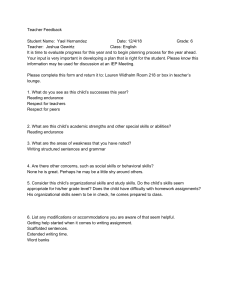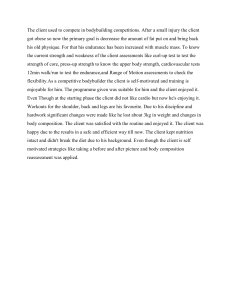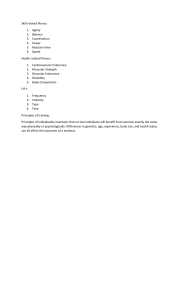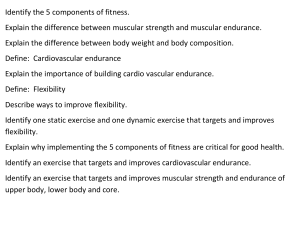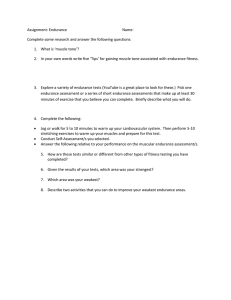Strength & Endurance Training Order: Running Economy & Performance
advertisement
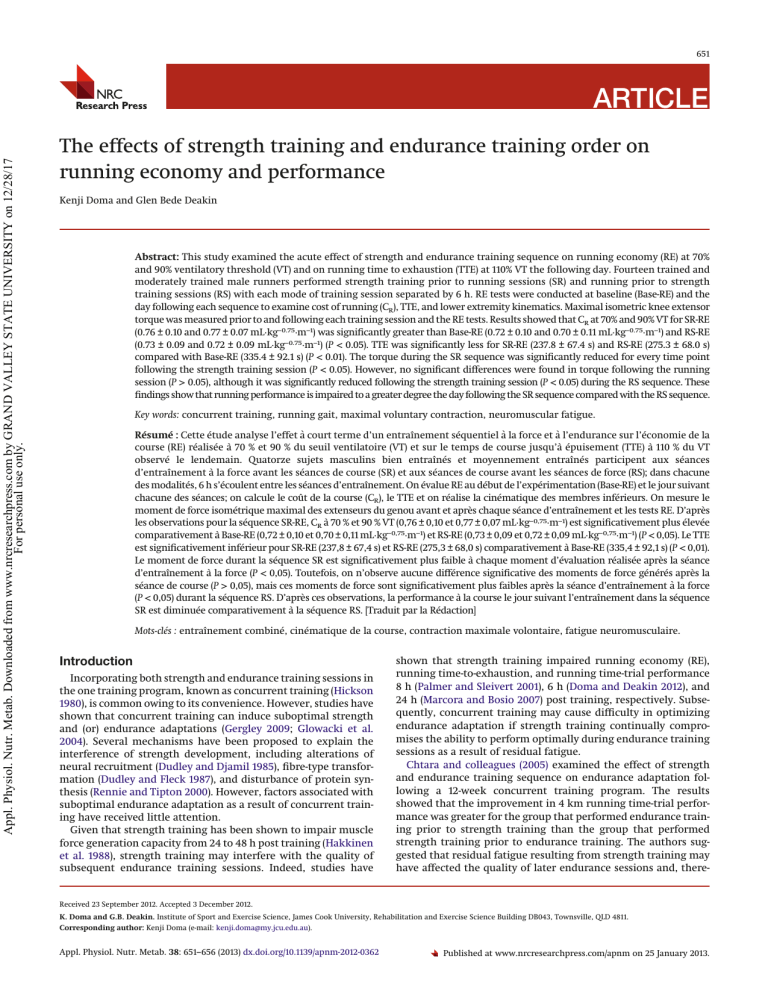
651 Appl. Physiol. Nutr. Metab. Downloaded from www.nrcresearchpress.com by GRAND VALLEY STATE UNIVERSITY on 12/28/17 For personal use only. ARTICLE The effects of strength training and endurance training order on running economy and performance Kenji Doma and Glen Bede Deakin Abstract: This study examined the acute effect of strength and endurance training sequence on running economy (RE) at 70% and 90% ventilatory threshold (VT) and on running time to exhaustion (TTE) at 110% VT the following day. Fourteen trained and moderately trained male runners performed strength training prior to running sessions (SR) and running prior to strength training sessions (RS) with each mode of training session separated by 6 h. RE tests were conducted at baseline (Base-RE) and the day following each sequence to examine cost of running (CR), TTE, and lower extremity kinematics. Maximal isometric knee extensor torque was measured prior to and following each training session and the RE tests. Results showed that CR at 70% and 90% VT for SR-RE (0.76 ± 0.10 and 0.77 ± 0.07 mL·kg–0.75·m–1) was significantly greater than Base-RE (0.72 ± 0.10 and 0.70 ± 0.11 mL·kg–0.75·m–1) and RS-RE (0.73 ± 0.09 and 0.72 ± 0.09 mL·kg–0.75·m–1) (P < 0.05). TTE was significantly less for SR-RE (237.8 ± 67.4 s) and RS-RE (275.3 ± 68.0 s) compared with Base-RE (335.4 ± 92.1 s) (P < 0.01). The torque during the SR sequence was significantly reduced for every time point following the strength training session (P < 0.05). However, no significant differences were found in torque following the running session (P > 0.05), although it was significantly reduced following the strength training session (P < 0.05) during the RS sequence. These findings show that running performance is impaired to a greater degree the day following the SR sequence compared with the RS sequence. Key words: concurrent training, running gait, maximal voluntary contraction, neuromuscular fatigue. Résumé : Cette étude analyse l’effet à court terme d’un entraînement séquentiel à la force et à l’endurance sur l’économie de la course (RE) réalisée à 70 % et 90 % du seuil ventilatoire (VT) et sur le temps de course jusqu’à épuisement (TTE) à 110 % du VT observé le lendemain. Quatorze sujets masculins bien entraînés et moyennement entraînés participent aux séances d’entraînement à la force avant les séances de course (SR) et aux séances de course avant les séances de force (RS); dans chacune des modalités, 6 h s’écoulent entre les séances d’entraînement. On évalue RE au début de l’expérimentation (Base-RE) et le jour suivant chacune des séances; on calcule le coût de la course (CR), le TTE et on réalise la cinématique des membres inférieurs. On mesure le moment de force isométrique maximal des extenseurs du genou avant et après chaque séance d’entraînement et les tests RE. D’après les observations pour la séquence SR-RE, CR à 70 % et 90 % VT (0,76 ± 0,10 et 0,77 ± 0,07 mL·kg–0,75·m–1) est significativement plus élevée comparativement à Base-RE (0,72 ± 0,10 et 0,70 ± 0,11 mL·kg–0,75·m–1) et RS-RE (0,73 ± 0,09 et 0,72 ± 0,09 mL·kg–0,75·m–1) (P < 0,05). Le TTE est significativement inférieur pour SR-RE (237,8 ± 67,4 s) et RS-RE (275,3 ± 68,0 s) comparativement à Base-RE (335,4 ± 92,1 s) (P < 0,01). Le moment de force durant la séquence SR est significativement plus faible à chaque moment d’évaluation réalisée après la séance d’entraînement à la force (P < 0,05). Toutefois, on n’observe aucune différence significative des moments de force générés après la séance de course (P > 0,05), mais ces moments de force sont significativement plus faibles après la séance d’entraînement à la force (P < 0,05) durant la séquence RS. D’après ces observations, la performance à la course le jour suivant l’entraînement dans la séquence SR est diminuée comparativement à la séquence RS. [Traduit par la Rédaction] Mots-clés : entraînement combiné, cinématique de la course, contraction maximale volontaire, fatigue neuromusculaire. Introduction Incorporating both strength and endurance training sessions in the one training program, known as concurrent training (Hickson 1980), is common owing to its convenience. However, studies have shown that concurrent training can induce suboptimal strength and (or) endurance adaptations (Gergley 2009; Glowacki et al. 2004). Several mechanisms have been proposed to explain the interference of strength development, including alterations of neural recruitment (Dudley and Djamil 1985), fibre-type transformation (Dudley and Fleck 1987), and disturbance of protein synthesis (Rennie and Tipton 2000). However, factors associated with suboptimal endurance adaptation as a result of concurrent training have received little attention. Given that strength training has been shown to impair muscle force generation capacity from 24 to 48 h post training (Hakkinen et al. 1988), strength training may interfere with the quality of subsequent endurance training sessions. Indeed, studies have shown that strength training impaired running economy (RE), running time-to-exhaustion, and running time-trial performance 8 h (Palmer and Sleivert 2001), 6 h (Doma and Deakin 2012), and 24 h (Marcora and Bosio 2007) post training, respectively. Subsequently, concurrent training may cause difficulty in optimizing endurance adaptation if strength training continually compromises the ability to perform optimally during endurance training sessions as a result of residual fatigue. Chtara and colleagues (2005) examined the effect of strength and endurance training sequence on endurance adaptation following a 12-week concurrent training program. The results showed that the improvement in 4 km running time-trial performance was greater for the group that performed endurance training prior to strength training than the group that performed strength training prior to endurance training. The authors suggested that residual fatigue resulting from strength training may have affected the quality of later endurance sessions and, there- Received 23 September 2012. Accepted 3 December 2012. K. Doma and G.B. Deakin. Institute of Sport and Exercise Science, James Cook University, Rehabilitation and Exercise Science Building DB043, Townsville, QLD 4811. Corresponding author: Kenji Doma (e-mail: kenji.doma@my.jcu.edu.au). Appl. Physiol. Nutr. Metab. 38: 651–656 (2013) dx.doi.org/10.1139/apnm-2012-0362 Published at www.nrcresearchpress.com/apnm on 25 January 2013. 652 Appl. Physiol. Nutr. Metab. Vol. 38, 2013 Appl. Physiol. Nutr. Metab. Downloaded from www.nrcresearchpress.com by GRAND VALLEY STATE UNIVERSITY on 12/28/17 For personal use only. Fig. 1. Schematic diagram demonstrating the progression of the sessions from the baseline running economy test (Base-RE), the strength session (ST) and running session (END), and the running economy tests during the strength–running sequence (SR-RE) and running–strength sequence (RS-RE). fore, attenuated optimal training stimuli for endurance adaptation. While these findings indicate that endurance adaptation may be influenced by the timing in which modes of exercises are prescribed, the acute effects of strength and endurance training sequence on running performance was not examined. A study conducted by Deakin (2004) investigated the acute sequence effect of strength and endurance training on submaximal cycling performance. In this study, strength and endurance exercises were performed 3 h apart in randomized order with a submaximal cycling performance test conducted 3 h following the last training session of each exercise sequence. The results showed that the physiological cost of cycling was greater 3 h after the sequence of strength–endurance training than after the sequence of endurance–strength training. These findings suggest that the strength–endurance sequence may have generated cumulative effects of fatigue. However, Deakin (2004) examined training sequence on endurance performance on the same day. Furthermore, the recovery period between strength and endurance training was only 3 h, with endurance performance measures limited to physiological cost of cycling prescribed at a single intensity on the same day. It is unknown whether the sequence of strength and endurance training sessions would have an impact on subsequent endurance performance the following day when the recovery period between each mode of training session is greater than 3 h. Such investigation would better represent a typical concurrent training day where one mode of training session is performed in the morning and the other in the afternoon. Furthermore, examining the sequence of strength and endurance training sessions the following day will shed light on the inter-day fatigue and recovery dynamics of a typically prescribed concurrent training program. To date, the investigation of strength and endurance training sequence, separated by 6 h, on submaximal (i.e., RE) and maximal (i.e., time to exhaustion) running performance the following day has not been conducted as far as the authors are aware. Furthermore, the impact of strength and endurance training sequence on running kinematics has not been examined. Determining the sequence effect of training on running performance the following day may shed light on the recovery dynamics during daily concurrent training sessions. The purpose of the current investigation was to systematically examine the acute effects of strength and endurance training sequence on RE, running time to exhaustion (TTE), and lower extremity running kinematics the following day. It was hypothesized that running performance will be impaired to a greater degree the following day when strength training precedes endurance training as opposed to endurance training followed by strength training. Methods Subjects Fourteen trained and moderately trained runners (mean ± standard deviation: age, 23.3 ± 6.1 years; height, 1.8 ± 0.1 m; body mass, 74.6 ± 8.0 kg; maximal oxygen uptake (V̇O2max), 62.0 ± 6.0 mL·kg–1·min–1) took part in the study. The trained runners were middle to long distance runners (1500–10 000 m), and all had run a 10 000 m time trial faster than 37 min during the last 6 months. The moderately endurance trained runners were undertaking 3 to 4 moderate to high intensity endurance training sessions per week and had various sporting backgrounds during the last 6 months. The participants did not undertake any lower extremity strength training exercises for at least 2 months prior to the study. Each participant completed an informed consent before taking part in any testing procedures, which were approved by the Institutional Human Research Ethics Committee and were run in accordance with the Declaration of Helsinki. Research design The study was conducted across 5 weeks with the first week consisting of a familiarization session and maximal oxygen consumption (V̇O2max) test. The familiarization session allowed participants to familiarize themselves with the protocols and equipment and to carry out a 6 repetition maximum (6RM) assessment. The V̇O2max test was a continuous incremental protocol that has been used previously (Doma et al. 2012a). The 6RM assessments were conducted as described previously (Baechle and Earle 2008) for incline leg press (Maxim MF701, Australia), leg extension, and leg curls (Avanti, B253 Olympic Bench, Australia). During the second week, the participants undertook 2 RE tests that were separated by at least 2 days for familiarization purposes as well as to provide a baseline for comparisons. The data collected during the second RE test was used as baseline (Base-RE). During the third week, 2 strength sessions were conducted as a washout period to standardize possible early onset of neuromuscular adaptations, since the use of the repeated bout effect (via the use of a second strength training session) has been shown to reduce the negative influence of a single strength training session on running performance (Burt et al. 2013). During the fourth and fifth week, participants undertook a running session 6 h following a strength session (SR sequence) and a strength session 6 h following a running session (RS sequence) in randomized order, with 7 days of recovery in between the 2 sequences (Fig. 1). A RE test was conducted 24 h following the strength session for the SR sequence (SR-RE) and 24 h following the running session for the RS sequence (RS-RE). The running sessions that were performed either prior to or following the strength sessions were treated as endurance training sessions, which were separate from the RE tests and were used to examine the acute sequence effect of strength and endurance (i.e., running session) training on running performance (i.e., RE test). Maximal voluntary contraction (MVC) tests were conducted prior to and following the strength sessions, running sessions, and RE tests for the SR and RS sequences. Technical and biological variations were controlled by calibrating all measurement equipment, requiring subjects to maintain their training intensity and volume during the course of the study, conducting the RE tests at the same time of day, subjects wearing the same shoes for every test, refraining from high intensity physical activity for at least 24 h prior to testing, and refraining from caffeine and food intake for at least 2 h prior to testing. Published by NRC Research Press Doma and Deakin 653 Appl. Physiol. Nutr. Metab. Downloaded from www.nrcresearchpress.com by GRAND VALLEY STATE UNIVERSITY on 12/28/17 For personal use only. Fig. 2. A schematic demonstrating the protocol of the running session with solid and dashed lines denoting running and rest, respectively. Strength session The exercises were performed in the order of incline leg press with 6 sets of 6 repetitions and leg extension and leg curls with 4 sets of 6 repetitions for each exercise. The exercises were performed in an order that would replicate a common procedure during strength training sessions where larger muscle groups are exercised first. A 3 min recovery period was provided between each set and between each of the strength training exercises. Running session Prior to the running session, a progressive warm-up was conducted on the treadmill, walking at 5 km·h–1 and then jogging at 8, 10, and 12 km·h–1 for 1 min, respectively. The running session was a 3-stage discontinuous incremental protocol, which was conducted on a treadmill and was similar to the RE test with the first 2 stages set at 70% and 90% of VT2 for 10 min. However, the last stage consisted of intervals with work-to-rest ratios of approximately 1:1 at 110% of VT2 (Fig. 2). Specifically, there were 4 intervals with a rest period of 1.5 min between the first, second, and third interval, and 2 min of rest between the third and fourth interval. There were also 2 min of rest between the 3 incremental stages. Running economy test The RE tests were conducted following a warm-up identical to that of the running session. The RE protocols consisted of 3 incremental stages running at 70%, 90%, and 110% of the second ventilatory threshold (VT2), respectively (Doma et al. 2012a). The participants ran for 10 min during the first 2 stages and then to exhaustion during the last stage to determine TTE. There were 2 min of passive rest between each stage. The VT2 for each subject was determined from the V̇O2max test by ascertaining the inflection point of ventilation (VE) with respect to carbon dioxide production on a scatter diagram (Neder and Stein 2006). The VT2 was used because of its high reliability (Neder and Stein 2006). The CR was used to indicate RE where V̇O2 is expressed in millilitres per kilogram to the power of 0.75 per metre (mL·kg–0.75·m–1). This particular expression for CR was selected, as it has been reported to minimize between-subject variability (Doma et al. 2012a). The CR was averaged during the last 5 min of the first 2 stages to ensure that the subjects reached steady-state running, which was defined as <10% change in V̇O2 per minute (Reeves et al. 2004). Values for rating of perceived exertion (RPE) were also collected on the 9th minute of the first 2 stages and every minute during the last stage (i.e., TTE). The RPE of the middle time points during the shortest TTE of a given RE test was used for comparisons (e.g., if the TTE for a given participant was 5 min for SR-RE, then the RPE for the third minute of SR-RE was compared with the third minute of Base-RE and RS-RE). The RPE collected during the 3 stages are expressed as RPE 1, RPE 2, and RPE 3, respectively, for the subsequent sections of the paper. Kinematic analyses Running gait was captured at 9 min 30 s of the first 2 stages of the Base-RE, SR-RE, and RS-RE tests. At least 10 strides of kinematic data were recorded for each motion captured at 100 Hz using a 3-dimensional 8-camera optical motion analysis system (VICON Motion Systems, Oxford, UK). Static calibrations for the optical cameras were completed for each testing session and ensured an image error of <0.15 pixels. The measuring volume covered 1.5 m × 3 m × 2 m (width, length, height). Body segments that were captured included the pelvis, thighs, shank, and feet using 16 retroreflective markers (14 mm diameter) that were placed by a single well-trained investigator (Nexus Plug-in Gait Model, Oxford, UK). Running gait parameters included ankle range of motion (AROM), maximum knee flexion during swing (KFS), maximum knee flexion after foot strike (KFAS), and hip range of motion (HROM) in the sagittal plane. Raw kinematic data were filtered using Woltring filtering routing. The mean-squared error was set to 20 mm2 in accordance with a detailed residual analysis (Winter 2008). Kinematic analysis during the last stage was not conducted because of its lesser reliability than the first 2 stages (Doma et al. 2012b). Maximal voluntary contraction test A custom-built dynamometer chair (James Cook University, Australia) was used to conduct the maximal isometric contractions of the knee extensor muscles. There were 3 contractions with each contraction held for 6 s and 1.5 min rest between each contraction (Doma and Deakin 2012). Torque was measured by positioning the knee joint at 110° with a force transducer secured superior to the medial and lateral malleoli. The dynamometer chair was calibrated by placing a known weight on the force transducer. Torque was calculated by averaging the values over the 6 s contraction, with the largest torque being reported among the 3 contractions. Sample size Following a pilot study on the reliability of the RE test and MVC test used in the current study, the within-subject coefficients of variation (CV) for CR, RPE, TTE, and torque production among trained and moderately endurance trained men (n = 14) were 2.5%, 3.6%, 9.2%, and 8.3%, respectively (Doma et al. 2012a). According to a nomogram for the estimation of measurement error with the use of CV (statistical power of 90%) (Atkinson and Nevill, 2006), the percentage worthwhile differences for the current sample size (n = 14) for CR, RPE, TTE, and torque production were found to be 3%, 4.5%, 11%, and 10%, respectively. These percentage differences are smaller than previous reports that have shown significant differences in the oxygen cost of running (Palmer and Sleivert 2001), RPE (Doherty et al. 2004), TTE (Esposito et al. 2012), and torque production (Palmer and Sleivert 2001) as a result of a particular intervention. Statistical analysis The measure of centrality and spread for all data are expressed as mean ± standard deviation. A one-way analysis of variance (ANOVA) with one between-subject factor, exercise order, was used to determine differences in CR, RPE, and TTE between BaseRE, SR-RE, and RS-RE. A 2-way ANOVA (time × sequence) with one between-subject factor, exercise order, was then used to determine differences in torque production for within and between the SR and RS sequences. Post hoc tests with Bonferroni’s pairwise adjustments were then used to locate the difference. The ␣ level Published by NRC Research Press 654 Appl. Physiol. Nutr. Metab. Downloaded from www.nrcresearchpress.com by GRAND VALLEY STATE UNIVERSITY on 12/28/17 For personal use only. Fig. 3. The cost of running (CR) for baseline running economy (BaseRE), running economy for the strength–running sequence (SR-RE), and running economy for the running–strength sequence (RS-RE) during Stages 1, 2, and 3. *, significantly greater than Base-RE at P < 0.05; **, significantly greater than RS-RE at P < 0.05. Appl. Physiol. Nutr. Metab. Vol. 38, 2013 Fig. 4. The rating of perceived exertion (RPE) for the baseline running economy (Base-RE), running economy for the strength–running sequence (SR-RE), and for the running–strength sequence (RS-RE) during Stages 1 (RPE 1), 2 (RPE 2), and 3 (RPE 3). *, significantly greater than Base-RE at P < 0.05; **, significantly greater than Base-RE at P < 0.01. was set at 0.05. All data were analysed using the Statistical Package for Social Sciences (SPSS, version 18, Chicago, Illinois). Results The CR was significantly greater for SR-RE (0.76 ± 0.10 and 0.77 ± 0.07 mL·kg–0.75·m–1) compared with Base-RE (0.72 ± 0.10 and 0.70 ± 0.11 mL·kg–0.75·m–1) and RS-RE (0.73 ± 0.09 and 0.72 ± 0.09 mL·kg–0.75·m–1) during stages 1 (P = 0.013, 0.047) and 2 (P = 0.014, 0.022), although no differences were found during stage 3 (P = 0.73) (Fig. 3). RPE 2 and RPE 3 were significantly greater for SR-RE compared with Base-RE (P = 0.002, 0.003), and RPE 2 and RPE 3 were significantly greater for RS-RE compared with Base-RE (P = 0.017, 0.030) (Fig. 4). The TTE was significantly less during SR-RE (237.8 ± 67.4 s) and RS-RE (275.3 ± 68.0 s) compared with Base-RE (335.4 ± 92.1 s) (P = 0.003, 0.008) (Fig. 5). The HROM was significantly less for SR-RE compared with Base-RE during stages 1 and 2 (P = 0.044, 0.019), and KFS was significantly less for SR-RE compared with Base-RE during stage 2 (P = 0.026) (Fig. 6). For the torque production, there was a significant effect of time (P = 0.001); however, no significant interaction effect was found for sequence (P > 0.05) (Fig. 7). Post hoc comparison showed that torque was significantly reduced for every 5 time points measured following the strength training session during the SR sequence (P = 0.001). For the RS sequence, no differences were found following the running session (P > 0.05); however, a significant reduction was measured for the 3 time points following the strength trainings session (P = 0.003, 0.002, 0.001). For the other performance variables no significant differences were found between the RE tests and between the other time points for torque (P > 0.05). Regarding cross randomization, no effect of exercise order was found for any of the variables measured (P > 0.05). Discussion The current study showed that CR was significantly greater and that HROM and KFS was significantly lower during SR-RE compared with Base-RE. However, TTE was significantly less and RPE was significantly greater during both SR-RE and RS-RE compared to Base-RE. These findings support the hypothesis that strength training before endurance training will impair running performance the following day to a greater degree compared to endurance training before strength training. The significant increase in CR during SR-RE with no differences found during RS-RE compared with Base-RE demonstrates that strength and endurance training sequence had an effect on running performance the following day. While Deakin (2004) exam- Fig. 5. The time-to-exhaustion (TTE) recorded for the baseline running economy (Base-RE), running economy for the strength–running sequence (SR-RE), and running economy for the running–strength sequence (RS-RE). *, significantly less than Base-RE at P < 0.01. ined strength and endurance training sequence on cycling performance on the same day, it was reported that the physiological cost of submaximal cycling was greater 3 h following strength–cycling compared with cycling–strength sequences. In light of the findings from the current study and that by Deakin (2004), strength training may be the primary mode of exercise contributing to the accumulation effect of fatigue responsible for impaired endurance performance. Previous reports have shown that the physiological cost of submaximal running (Palmer and Sleivert 2001) and cycling (Deakin 2004) increased 8 and 3 h, respectively, following strength training. It has been reported that venous blood oxygen saturation decreases during isometric contraction of the forearm (Barcroft et al. 1963), suggesting that oxygen extraction increases with sustained muscle contraction. Further, Yamada and colleagues (2008) showed a significant relationship between reduction in muscle activity and changes in muscle oxygenation during submaximal isometric contractions. From these previous findings, it is assumable that CR in the current study may have increased because of Published by NRC Research Press Doma and Deakin Appl. Physiol. Nutr. Metab. Downloaded from www.nrcresearchpress.com by GRAND VALLEY STATE UNIVERSITY on 12/28/17 For personal use only. Fig. 6. The angular displacements of the hip range of motion (HROM), knee flexion during swing phase (KFS), knee flexion after foot strike (KFAS), and ankle range of motion (AROM) for the baseline running economy test (Base-RE) and running economy tests for the strength– running sequence (SR-RE) and the running–strength sequence (RS-RE) during Stages 1 (a) and 2 (b). *, significantly less than Base-RE at P < 0.05. Fig. 7. The torque production at time points prior to (1) and following (2) the strength training session, prior to (3) and following (4) the endurance training session, and prior to (5) and following (6) the running economy test for the SR sequence, and prior to (1) and following (2) the endurance training session, prior to (3) and following (4) the strength training session, and prior to (5) and following (6) the running economy test for the RS sequence. *, significantly less than time point 1 at P < 0.05; †, significantly less than at time point 1 at P < 0.01; ‡, significantly less than time point 3 at P < 0.01. greater oxygen extraction from the muscles of the lower extremity compared with running in a non-fatigued state. Furthermore, changes in oxygen metabolism may have occurred because of inefficient neural recruitment patterns, as indicated by alterations in 655 lower extremity kinematics due to pre-existent local muscle fatigue from previous strength and endurance training sessions. Given that a 6 h recovery period was incorporated between strength and endurance training in the current study, the endurance training session may have been performed in a preexhausted state due to residual fatigue from the preceding strength training session. This is supported by the significant reduction in MVC prior to the running session during the SR sequence. However, MVC returned to baseline values 6 h following the running session during the RS sequence, suggesting that possible residual effects of fatigue generated from the running sessions may have been eliminated prior to the strength training session. Consequently, an accumulation effect of fatigue appears not to have occurred during the RS sequence over the 2-day testing period. Indeed, studies have reported that strength training reduces MVC from 24 to 48 h, with the reduction being attributed to depletion of muscle glycogen (Green 1990), muscle soreness, and muscle damage (Skurvydas et al. 2011). Alternatively, it has been shown that MVC is not affected 24 h following 60 min of moderate to high intensity endurance training (Bentley et al. 2000). Subsequently, endurance training performed following strength training may augment the physiological responses induced by strength training (e.g., muscle glycogen depletion, muscle soreness and muscle damage) and thereby attenuate RE the following day. The TTE was significantly reduced for both SR-RE and RS-RE, demonstrating that running at maximum effort is impaired the day following strength and endurance training regardless of the sequence of the mode of training. However, no differences were found in CR during stage 3 between Base-RE, SR-RE, and RS-RE. These findings indicate that the participants’ physiological state was similar at exhaustion despite differences in TTE. Subsequently, the rate of increase in fatigue may have been greater during SR-RE and RS-RE than Base-RE and, therefore contributed to terminating their running earlier. Interestingly, the difference in TTE between SR-RE and RS-RE was 10%, which is in proximity to the worthwhile differences (i.e., 11%) for TTE determined for the RE protocol with the current sample size (n = 14). In addition, RPE 3 was significantly greater during SR-RE, although no significant differences were found in RPE for this particular time point during TTE. As a result, the subjects in the current study appeared to perceive running to be harder midway through TTE during SR-RE compared with RS-RE, indicating a sequence effect above VT2. While a reduction in MVC may have contributed to an increase in CR during SR-RE in the present study, no significant relationship was found between the percentage differences in CR and MVC for the SR and RS sequences. These findings confirm that of Chen et al. (2007) where MVC remained reduced for 5 days following downhill running, although RE was impaired for only 2 days. Palmer and Sleivert (2001) also found no effect on MVC 8 h following strength training, yet RE was impaired. This lack of relationship between MVC and CR would be expected, as reports have shown that RE was impaired following strenuous exercises with an increase in muscle soreness and muscle damage (Chen et al. 2007), elevation in level of perceived exertion, and alterations in running kinematics (Bonacci et al. 2010). Subsequently, the physiological process contributing to the decrement in RE appears to be complex, involving various mechanisms. In addition, running is performed dynamically, requiring multiple muscle groups to contract repetitively in short bursts while performing various contraction types (e.g., concentric, eccentric, and isometric contractions). Thus, it is difficult to directly relate running performance measures to a single 6 s isometric contraction of one muscle group. Nonetheless, given that the effect of strength and endurance training sequence was similar between CR and MVC, the impaired properties of the muscle may in part have contributed to an increase in CR in the present study. In addition to an increase in CR, significant reductions were found in HROM and KFS during SR-RE, although no significant differences were found in the selected kinematic parameters during RS-RE, sugPublished by NRC Research Press Appl. Physiol. Nutr. Metab. Downloaded from www.nrcresearchpress.com by GRAND VALLEY STATE UNIVERSITY on 12/28/17 For personal use only. 656 gesting that the sequence effect of strength and endurance training was also present in running kinematics. The current study is the first to examine the effect of strength and endurance training sequence on running gait patterns, as far as the authors are aware. Subsequently, directly comparing the kinematic results from the current study with those in the literature is at present difficult. However, given that MVC was consistently reduced during the SR sequence, neuromuscular fatigue may have caused inefficient motor unit recruitment patterns thereby altering running kinematics. Various studies have shown reductions in lower extremity joint range of motion during running as a result of neuromuscular fatigue following resistive-type exercises (Chen et al. 2007; Paschalis et al. 2007). It has been postulated that lower extremity range of motion may be compromised owing to delayed onset of muscle soreness, inefficient neural recruitment patterns, and decreased ability to use the stretchshortening cycle (Chen et al. 2007; Braun and Dutto 2003). The reduction in KFS in the current study may have caused an increase in hip flexor torque due to greater moment of inertia. These biomechanical modifications reduce the efficiency of movement, thus increase the energy expenditure required for running. Subsequently, alterations in running kinematics may have contributed to the increased CR during SR-RE in the current study. In summary, strength training performed prior to endurance training causes greater attenuation in running performance assessed 24 h later than does endurance training performed prior to strength training. This sequence effect was also evident for alterations in lower extremity running kinematics. This phenomenon may occur owing to endurance exercises augmenting the duration of fatigue generated by preceding strength training sessions. The current study showed that the SR sequence increased CR at submaximal intensities with a concomitant reduction in MVC and alterations in running kinematics. The increase in the physiological cost of running as a result of performing strength and endurance training would hinder performance during a running session and impair optimum stimulus for training adaptation. From a practical view, running sessions at submaximal intensities should be performed the day after the RS sequence as opposed to the SR sequence. However, given that TTE was significantly less during both SR-RE and RS-RE, a recovery period of more than 1 day may be required following strength and endurance training regardless of the sequence of the mode of training when performing a high intensity running session. While the current study demonstrated the sequence effect of strength and endurance training on running performance the following day, future research could examine this phenomenon over multiple days (e.g., 48 and 72 h post training) to enhance the understanding of fatigue and recovery dynamics as a result of concurrently training each mode of training session. Acknowledgements The authors would like to thank Lucy Keast and Heidi Jenninson for their assistance with data collection and to Marian Dohma for her assistance with editing this manuscript. References Atkinson, G., and Nevill, A.M. 2006. Sport and exercise physiology testing guidelines: sport testing. Vol. 1. 3rd ed. Routledge, London, UK. Baechle, T.R., and Earle, R.W. 2008. Essentials of strength training and conditioning. 3rd ed. Human Kinetics, Champaign, Ill., USA. Barcroft, H., Grenwood, B., and Whelan, R.F. 1963. Blood flow and venous oxygen saturation during sustained contraction of forearm. J. Physiol. 198: 848–856. PMID:14072861. Bentley, D.J., Smith, P.A., Davie, A.J., and Zhou, S. 2000. Muscle activation of the knee extensors following high intensity endurance exercise in cyclists. Eur. J. Appl. Physiol. 81(4): 297–302. doi:10.1007/s004210050046. PMID:10664088. Bonacci, J., Green, D., Saunders, P.U., Blanch, P., Franettovich, M., Chapman, A.R., et al. 2010. Change in running kinematics after cycling are related to alterations in running economy in triathletes. J. Sci. Med. Sport. 13(4): 460–464. doi:10.1016/j.jsams.2010.02.002. PMID:20359948. Braun, W.A., and Dutto, D.J. 2003. The effects of a single bout of downhill running and ensuing delayed onset of muscle soreness on running economy Appl. Physiol. Nutr. Metab. Vol. 38, 2013 performed 48 h later. Eur. J. Appl. Physiol. Occup. Physiol. 90(1–2): 29–34. doi:10.1007/s00421-003-0857-8. PMID:12783232. Burt, D., Lamb, K., Nicholas, C., and Twist, C. 2013. Effects of repeated bouts of squatting exercise on sub-maximal endurance performance. Eur. J. Appl. Physiol. 113(2): 285–293. doi:10.1007/s00421-012-2437-2. PMID:22684335. Chen, T.C., Nosaka, K., and Tu, J.H. 2007. Changes in running economy following downhill running. J. Sports Sci. 25(1): 55–63. doi:10.1080/02640410600718228. PMID:17127581. Chtara, M., Chamari, K., Chaouachi, M., Chaouachi, A., Koubaa, D., Feki, Y., et al. 2005. Effects of intra-session concurrent endurance and strength training sequence on aerobic performance and capacity. Br. J. Sports Med. 39(8): 555– 560. doi:10.1136/bjsm.2004.015248. PMID:16046343. Deakin, G.B. 2004. Concurrent training in endurance athletes: the acute effects on muscle recovery capacity, physiological, hormonal and gene expression responses post-exercise. Southern Cross University, Lismore. Doherty, M., Smith, P., Hughes, M., and Davidson, R. 2004. Caffeine lowers perceptual response and increase power output during high-intensity cycling. J. Sports Sci. 22: 637–643. doi:10.1080/02640410310001655741. PMID: 15370494. Doma, K., and Deakin, G.B. 2012. The acute effects of intensity- and volume- of strength training on running performance. Eur. J. Sport Sci. In press. doi:10. 1080/17461391.2012.726653. Doma, K., Deakin, G.B., Sealey, R.M., and Leicht, A.S. 2012a. The reliability of running economy among trained distance runners and field-based players. J. Exerc. Sci. Fit. In press. doi:10.1016/j.jesf.2012.10.006. Doma, K., Deakin, G.B., and Sealey, R.M. 2012b. The reliability of lower extremity and thoracic kinematics at various running speeds. Int. J. Sports Med. 33(5): 364–369. doi:10.1055/s-0031-1299751. PMID:22377953. Dudley, G.A., and Djamil, R. 1985. Incompatability of endurance- and strengthtraining modes of exercise. J. Appl. Physiol. 59(5): 1446–1451. PMID:4066574. Dudley, G.A., and Fleck, S.J. 1987. Strength and endurance training. Are they mutually exclusive? Sports Med. 4: 79–85. doi:10.2165/00007256-19870402000001. PMID:3299613. Esposito, F., Ce, E., and Limonta, E. 2012. Cycling efficiency and time to exhaustion are reduced after acute passive stretching administration. Scand. J. Med. Sci. Sports. 22(6):737–744. doi:10.1111/j.1600-0838.2011.01327.x. PMID: 21564308. Gergley, J.C. 2009. Comparison of two lower-body modes of endurance training on lower-body strength development while concurrently training. J. Strength Cond. Res. 23(3): 979–987. Glowacki, S.P., Martin, S.E., Maurer, A., Baek, W., Green, H.J., and Crouse, S.F. 2004. Effects of resistance, endurance, and concurrent exercise on training outcomes in men. Med. Sci. Sport Exerc. 36(12): 2119–2127. PMID:15570149. Green, H.J. 1990. How important is endogenous muscle glycogen to fatigue in prolonged exercise? Can. J. Physiol. Pharmacol. 69(2): 290–297. doi:10.1139/ y91-045. PMID:2054746. Hakkinen, K., Pakarinen, A., Alen, M., Kauhanen, H., and Komi, P.V. 1988. Daily hormonal and neuromuscular responses to intensive strength training in 1 week. Int. J. Sports Med. 9(6): 422–428. doi:10.1055/s-2007-1025044. PMID: 3253232. Hickson, R.C. 1980. The interference effects of training for strength and endurance simultaneously. Eur. J. Appl. Physiol. Occup. Physiol. 45(2–3): 255–263. doi:10.1007/BF00421333. Marcora, S.M., and Bosio, A. 2007. Effect of exercise-induced muscle damage on endurance running performance in humans. Scand. J. Med. Sci. Sports, 17(6): 662–671. doi:10.1111/j.1600-0838.2006.00627.x. PMID:17346288. Neder, J.A., and Stein, R. 2006. A simplified strategy for the estimation of the exercise ventilatory thresholds. Med. Sci. Sports Exerc. 38(5): 1007–1013. doi: 10.1249/01.mss.0000218141.90442.6c. PMID:16672856. Palmer, C.D., and Sleivert, G.G. 2001. Running economy is impaired following a single bout of resistance exercise. J. Sci. Med. Sport, 4(4): 447–459. doi:10.1016/ S1440-2440(01)80053-0. PMID:11905938. Paschalis, V., Giakas, G., Baltzopoulos, V., Jamurtas, A.Z., Theoharis, V., Kotzamanidis, C., et al. 2007. The effects of muscle damage following eccentric exercise on gait biomechanics. Gait Posture, 25(2): 236–242. doi:10.1016/ j.gaitpost.2006.04.002. PMID:16714113. Reeves, M.M., Davies, P.S., Bauer, J., and Battistutta, D. 2004. Reducing the time period of steady state does not affect the accuracy of energy expenditure measurements by indirect calorimetry. J. Appl. Physiol. 97(1): 130–134. doi:10. 1152/japplphysiol.01212.2003. Rennie, M.J., and Tipton, K.D. 2000. Protein and amino acid metabolism during and after exercise and the effects of nutrition. Annu. Rev. Nutr. 20: 457–483. doi:10.1146/annurev.nutr.20.1.457. PMID:10940342. Skurvydas, A., Brazaitis, M., Venckunas, T., Kamandulis, S., Stanislovaitis, A., and Zuoza, A. 2011. The effect of sports specialization on musculus quadriceps function after exercise-induced muscle damage. Appl. Physiol. Nutr. Metab. 36(6): 873–880. doi:10.1139/h11-112. PMID:22050132. Winter, D.A. 2008. Biomechanics and motor control of human movement. 4th ed. John Wiley & Sons, Inc., Hoboken, N.J., USA. Yamada, E., Kusaka, T., Arima, N., Isobe, K., Yamamoto, T., and Itoh, S. 2008. Relationship between muscle oxygenation oand electromyography activity during sustained isomeric contraction. Clin. Physiol. Funct. Imaging, 28: 216–221. doi:10.1111/j.1475-097X.2008.00798.x. PMID:18355343. Published by NRC Research Press
